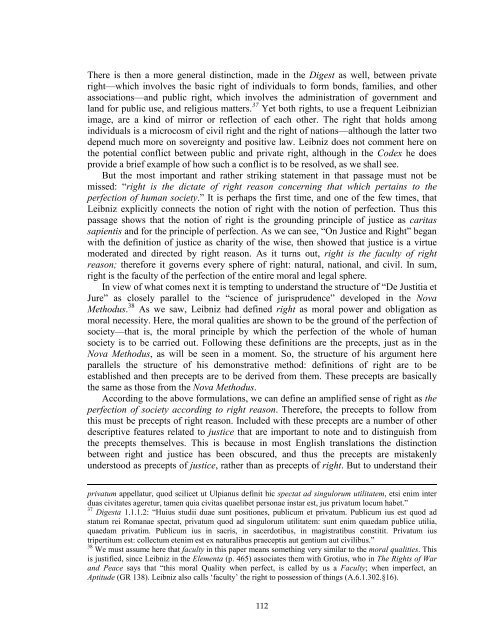Stony Brook University
Stony Brook University
Stony Brook University
You also want an ePaper? Increase the reach of your titles
YUMPU automatically turns print PDFs into web optimized ePapers that Google loves.
There is then a more general distinction, made in the Digest as well, between private<br />
right—which involves the basic right of individuals to form bonds, families, and other<br />
associations—and public right, which involves the administration of government and<br />
land for public use, and religious matters. 37 Yet both rights, to use a frequent Leibnizian<br />
image, are a kind of mirror or reflection of each other. The right that holds among<br />
individuals is a microcosm of civil right and the right of nations—although the latter two<br />
depend much more on sovereignty and positive law. Leibniz does not comment here on<br />
the potential conflict between public and private right, although in the Codex he does<br />
provide a brief example of how such a conflict is to be resolved, as we shall see.<br />
But the most important and rather striking statement in that passage must not be<br />
missed: “right is the dictate of right reason concerning that which pertains to the<br />
perfection of human society.” It is perhaps the first time, and one of the few times, that<br />
Leibniz explicitly connects the notion of right with the notion of perfection. Thus this<br />
passage shows that the notion of right is the grounding principle of justice as caritas<br />
sapientis and for the principle of perfection. As we can see, “On Justice and Right” began<br />
with the definition of justice as charity of the wise, then showed that justice is a virtue<br />
moderated and directed by right reason. As it turns out, right is the faculty of right<br />
reason; therefore it governs every sphere of right: natural, national, and civil. In sum,<br />
right is the faculty of the perfection of the entire moral and legal sphere.<br />
In view of what comes next it is tempting to understand the structure of “De Justitia et<br />
Jure” as closely parallel to the “science of jurisprudence” developed in the Nova<br />
Methodus. 38 As we saw, Leibniz had defined right as moral power and obligation as<br />
moral necessity. Here, the moral qualities are shown to be the ground of the perfection of<br />
society—that is, the moral principle by which the perfection of the whole of human<br />
society is to be carried out. Following these definitions are the precepts, just as in the<br />
Nova Methodus, as will be seen in a moment. So, the structure of his argument here<br />
parallels the structure of his demonstrative method: definitions of right are to be<br />
established and then precepts are to be derived from them. These precepts are basically<br />
the same as those from the Nova Methodus.<br />
According to the above formulations, we can define an amplified sense of right as the<br />
perfection of society according to right reason. Therefore, the precepts to follow from<br />
this must be precepts of right reason. Included with these precepts are a number of other<br />
descriptive features related to justice that are important to note and to distinguish from<br />
the precepts themselves. This is because in most English translations the distinction<br />
between right and justice has been obscured, and thus the precepts are mistakenly<br />
understood as precepts of justice, rather than as precepts of right. But to understand their<br />
privatum appellatur, quod scilicet ut Ulpianus definit hic spectat ad singulorum utilitatem, etsi enim inter<br />
duas civitates ageretur, tamen quia civitas quaelibet personae instar est, jus privatum locum habet.”<br />
37 Digesta 1.1.1.2: “Huius studii duae sunt positiones, publicum et privatum. Publicum ius est quod ad<br />
statum rei Romanae spectat, privatum quod ad singulorum utilitatem: sunt enim quaedam publice utilia,<br />
quaedam privatim. Publicum ius in sacris, in sacerdotibus, in magistratibus constitit. Privatum ius<br />
tripertitum est: collectum etenim est ex naturalibus praeceptis aut gentium aut civilibus.”<br />
38 We must assume here that faculty in this paper means something very similar to the moral qualities. This<br />
is justified, since Leibniz in the Elementa (p. 465) associates them with Grotius, who in The Rights of War<br />
and Peace says that “this moral Quality when perfect, is called by us a Faculty; when imperfect, an<br />
Aptitude (GR 138). Leibniz also calls ‘faculty’ the right to possession of things (A.6.1.302.§16).<br />
112
















